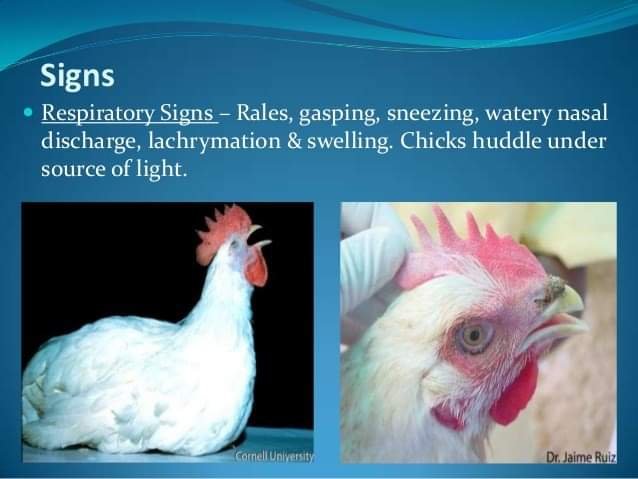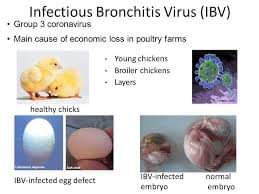Dr Deepak Prasad Sinha, Poultry Consultant, Patna.
INTRODUCTION
Infectious bronchitis (IB) is a contagious and a very serious respiratory viral disease of poultry. It is one of the most common viral infections of chickens all over the world. The virus is believed to, a part from respiratory diseases, cause urogenital tract disease of birds. Infectious bronchitis may also be the primary factor in serious outbreaks of mixed respiratory tract infections. involving Mycoplasma organisms, bacteria, particularly Eschericia coli. Infectious bronchitis (I.B) is the most contagious poultry disease. It has very similar symptoms to mycoplasma. The main difference is the number of birds it affects.
Mycoplasma tends to affect a few birds in the flock but IB spreads within a few days to the whole flock. I.B. causes respiratory disease and kidney damage in growers and oviduct infection in adult hens which can cause wrinkled egg shells, as well as a reduction in egg laying. It can also affect the ability of the bird to produce thick albumen (white) which means eggs can have watery whites.
• This is a highly infectious and contagious respiratory disease of chicks. Also affect the oviduct, and some strains have a tendency for the kidneys.
• Disease can occur at any stage, but young chicks, especially under 6 weeks of age are more susceptible.
• Great economic importance due to its adverse effect on egg production and egg quality in layers, and on production in broilers.
• Other pathogen such as Mycoplasma or E.coli increases the severity and duration of the disease.
Causes———-
• The virus belongs to corona group of virus.
• Virus is fragile in nature and gets destroyed by common physical and chemical agents.
• Infection is by inhalation of droplets, through ingestion of feed and water contaminated with virus and by contact with infected birds, contaminated movable equipments, clothing and personnel.
• Virus is present in respiratory discharges, faeces and eggshells of infected birds.
• This virus survives well outside the body during winter therefore, disease incidence and spread is more during winter than other seasons, though disease can occur in any season.
• Spreads very rapidly in the flock.
• Bird to bird by direct transmission.
• Transmission through eggs.
• Fomites also can transmit the disease.
Clinical symptoms—————–
The clinical signs of the infection vary and depend on the age of the bird, host immune status, and virulence of the virus. In chicks, depression, ruffled feathers, and huddling near heat sources are common early signs. Within 24 hours, respiratory signs are typically observed and may include coughing, sneezing, nasal discharge, tracheal rales, and gasping. Ocular discharge (epiphora) may be present and the sinuses may become swollen. Feed intake may drop and subsequent weight loss may be observed. Chicks, less than 2-weeks of age may suffer damage to the oviduct, resulting in permanent impairment to their egg-laying capacity. Some highly virulent strains have also been associated with facial edema and airsacculitis.
In birds older than 6 weeks of age, the signs are similar but often less severe. In adults, respiratory signs may be so subtle as to be observable only at night when the birds are normally quiet. In layers, egg production may drop by up to 50% (depending on virus strain and period of lay) and eggs are often misshapen, soft-shelled, and contain watery albumen. Birds that recover from the infection may never return to pre-infection egg laying levels.
Some strains of IBV are nephropathogenic. Birds generally recover from early respiratory signs only to later develop diarrhea, sometimes with fatal secondary urolithiasis.
Clinical signs: ——

Chicks less than 2 weeks old—
• Depression, ruffled feathers, huddling near heat sources Coughing, sneezing, nasal discharge Gasping, tracheal rales Ocular discharge (epiphora) Swollen sinuses Decreased feed intake, weight loss +/- Permanent damage to oviduct o Impairs egg-laying capacity
Young chickens more than 6 weeks of age—-
• Similar signs, but LESS severe bacterial sinusitis Facial swelling with concurrent 2
Adults—
• More subtle respiratory signs o Observable only when birds quiet (night) Nephropathogenic strains Birds recover from early respiratory signs o Develop diarrhea o +/- Fatal secondary urolithiasis
Broilers—–
• Poor feed conversion and reduced growth rate Condemnation of meat at processing
Layers—-
• Decreased egg production (up to 50%) Abnormal eggs o Misshapen, ‘Wrinkled’ eggs o Thin-shelled o Watery albumen o Abnormal color, surface
• In young chicks upto 6 weeks of age, respiratory signs like sneezing, coughing, gasping, tracheal rales, lachrymation and nasal discharge are more common.
• The chicks will huddle under the hover.
• There may be swelling of sinuses and face.
• In chicks, mortality may as high as 25%-60% and the course of disease is 1-2 weeks.
• Respiratory noises can be heard more distinctly during night when chicks are normally quite.
• In growers and adult birds, signs of less intensity are seen with less occurrence of nasal discharge and mortality is negligible.
• In laying birds, egg production declines (5-50%) rapidly.
• Damage to functional oviduct in adults (most common).
• Egg abnormalities (Production of misshapen, thin or soft –shelled, rough, smaller, corrugations and leathery eggs).
• The egg quality is poor with thin or watery white albumin.
• In uraemic form, birds exhibit depression, ruffled feathers, wet droppings, increased water intake and increased mortality (0.5-1% per week) due to urolithiasis (Kidney stones).
Gross lesions—————
• Serous, catarrhal, or caseous exudates in the trachea and bronchi lumen, generally without haemorrhages.
• Plugs of yellow caseous material obstructing the bronchi and lower parts of trachea of chicks that dies.
• Fluid yolk material may be found in the abdominal.
• Abnormal ovary having the misshapen follicle.
• Middle third of the oviduct may appear atrophied and ova ruptured into abdominal cavity.
• Swollen, pale kidneys and deposits of urates in kidney, ureters and throughout the body.
Post-mortem Lesions——–
The trachea, nasal passages, and sinuses may be edematous and typically have serous, catarrhal, or caseous exudate present on post-mortem examination. A caseous plug may occlude the trachea or bronchi in dead chicks. The lungs may show evidence of pneumonia. The air sac membranes may be cloudy and caseous yellow exudate may be present. The kidneys may be swollen and pale, due to interstitial nephritis and necrosis, and white urates may be present in increased amounts in the distended tubules and ureters. The oviduct may be occluded and hypoglandular. Egg yolk peritonitis may be found within the coelomic cavity, secondary to ruptured follicles.
Differential Diagnosis———–
The clinical signs of IB may resemble other acute respiratory diseases in chickens, such as Newcastle disease, laryngotracheitis, avian influenza and infectious coryza. Laboratory testing is necessary to differentiate these infections. In IB, allantoic fluid from inoculated embryos does not hemagglutinate erythrocytes. For Newcastle disease virus, and avian influenza virus, allantoic fluid from inoculated embryos will be positive for hemagglutination.
Diagnosis————
Clinical history, gross lesions, seroconversion and molecular tests for antigen and viral nucleic acid detection are commonly used to diagnose infectious bronchitis.
Diagnostic samples should be collected as soon as clinical signs are observed. Tracheal swabs should be collected from 5-10 birds per affected flock. Additionally, paired serum samples should be collected. Fresh tissue samples should be taken from the lung, kidney, oviduct, and cecal tonsils using aseptic technique. Swabs and tissue samples should be frozen and all samples shipped to the laboratory.
In the laboratory, swab tube broth or tissue homogenates are used to inoculate 9 to 11 day old embryonated eggs. After several days, chorioallantoic fluid is harvested and should produce a negative hemagglutination reaction with chicken red blood cells. Curling, stunting and death of embryos can be seen in IBV positive embryos. Confirmation of IBV, and its serotypes, can be performed by various antibody detection methods including: virus neutralization (VN), immunoflourescent antibody assay (IFA), antigen-capture enzyme-linked immunosorbent assay (AC-ELISA), and monoclonal antibodies. However, only the VN test and some monoclonal antibodies can distinguish between different serotypes. Reverse transcriptase-polymerase chain reaction (RT-PCR), followed by restriction fragment length polymorphism (RFLP), and/or sequencing of the S1 gene are commonly used to identify IBV types. The immunoflourescent antibody assay (IFA) or electron microscopy can be used on tracheal samples for rapid diagnosis but those tests do not distinguish between different IBV types.
Seroconversion, and specifically a rise in IBV antibody titer indicating IBV infection, is determined by ELISA, VN test, modified hemagglutination inhibition (HI), immunofluorescence, and immunodiffusion tests.
Prevention and Control———–
Prevention and control in the field is difficult using common sanitary and biosecurity measures because IBV is highly infectious. Good cleaning and disinfection practices, during the downtime period, may help to prevent recurrent infections in problem farms. Farm complexes with multiple ages, such as the ones that have table egg layers, are a common source of infection. In these types of flocks, it is very common to see drops in egg production due to chronic disease.
Infectious bronchitis is extremely difficult to control because different serotypes of the virus do not cross-protect. Attenuated live and inactivated vaccines are used for infectious bronchitis immunization. Attenuated live vaccines delivered in the drinking water or by spray, are commonly used in broilers and for the initial vaccination of laying birds. Inactivated oil-emulsion vaccines are used in breeders and layers before the beginning of the production cycle. The administration is performed either by intramuscular or subcutaneous injection. These types of vaccines reduce the incidence of viral replication in the respiratory tract and may limit the spread and transmission to other susceptible birds. Broilers are commonly vaccinated with a live vaccine in the hatchery, followed by a second vaccination of the same or different serotype between 10 and 18 days of age.
No specific treatment exists for infectious bronchitis. The use of antibacterials against secondary opportunistic bacterial infections in the first stages of the disease may reduce the incidence of severe multifactorial respiratory disease, associated with poor conversion performance and increased mortality.


